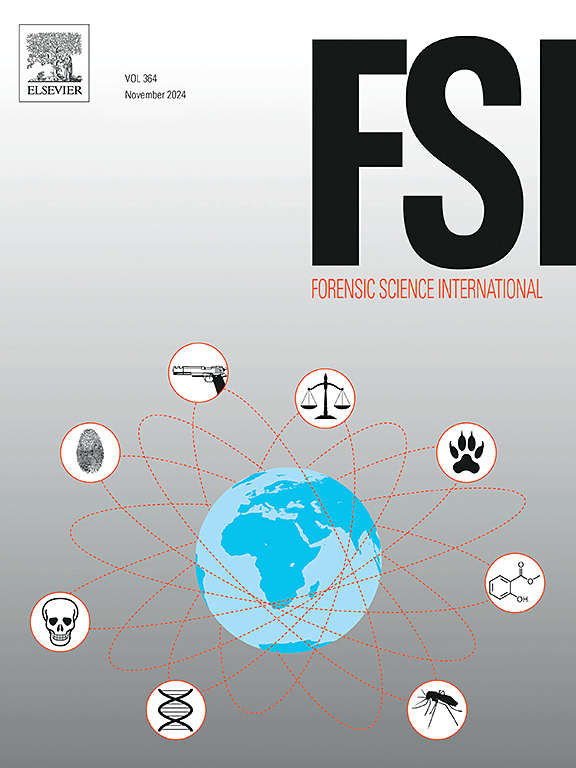The persistence of bloodstains on buried fabrics and robustness of the leucomalachite green test in detecting aged bloodstains on buried fabrics
IF 2.2
3区 医学
Q1 MEDICINE, LEGAL
引用次数: 0
Abstract
Understanding the persistence and detection of bloodstains in different casework scenarios can inform the development of appropriate examination strategies, prioritisation of exhibits for DNA analysis, interpretation of test results, and evidence evaluation. This study investigated how soil burial impacts the persistence and detection of bloodstains on cotton, polyester, and wool fabrics over 9 weeks. Bloodstained fabric samples were buried in topsoil and evaluated weekly using the Leucomalachite Green (LMG) test, rated on a scale from 1 to 5 for colour intensity. Surface-level fabrics were compared to buried fabrics to assess burial effects on persistence of bloodstains and performance of the LMG test. Bloodstains on fabrics showed significant degradation and loss over a 9-week burial period, with wool being the most persistent, followed by polyester and cotton. Kruskal-Wallis H tests revealed significant differences in colour intensity scores by fabric type and burial duration (p < 0.001). Mann-Whitney U tests indicated significant differences between fabric types (p < 0.001) and notable degradation and loss from week 1 onward (p < 0.001). These findings are vital as it showed that the LMG test is not robust in detecting aged bloodstains from buried cotton and polyester textiles. Further, in combination with other blood markers (such as DNA or RNA), the persistence pattern observed using the LMG test could potentially inform the estimation of time since deposition of stains. The data generated can inform best practices for the prioritisation of buried exhibits for DNA analysis and storage of recovered buried clothing.
埋地织物上血迹的持久性及白孔雀石绿试验检测埋地织物上旧血迹的稳健性
了解不同办案环境下血迹的持久性和检测情况有助于制定适当的检查策略、确定 DNA 分析物证的优先顺序、解释检测结果以及评估证据。本研究调查了土壤掩埋如何影响棉、涤纶和羊毛织物上血迹在 9 周内的持久性和检测。血迹织物样本被埋在表层土壤中,每周使用白云母绿(LMG)测试进行评估,颜色强度从 1 到 5 级。将表面织物与埋藏的织物进行比较,以评估埋藏对血迹持久性和 LMG 测试性能的影响。在 9 周的掩埋期中,织物上的血迹出现了明显的降解和损失,其中羊毛的血迹最持久,其次是涤纶和棉。Kruskal-Wallis H 检验表明,不同织物类型和掩埋时间对颜色强度的影响存在显著差异(p < 0.001)。Mann-Whitney U 检验表明,不同织物类型之间存在显著差异(p < 0.001),从第 1 周起,织物的降解和损失明显(p < 0.001)。这些发现非常重要,因为它表明 LMG 检验在检测埋入地下的棉质和涤纶纺织品中的老化血迹方面并不可靠。此外,结合其他血液标记物(如 DNA 或 RNA),使用 LMG 检验所观察到的持续模式有可能为估计血迹沉积时间提供依据。所生成的数据可为优先对埋藏物进行 DNA 分析和储存回收的埋藏衣物提供最佳实践信息。
本文章由计算机程序翻译,如有差异,请以英文原文为准。
求助全文
约1分钟内获得全文
求助全文
来源期刊

Forensic science international
医学-医学:法
CiteScore
5.00
自引率
9.10%
发文量
285
审稿时长
49 days
期刊介绍:
Forensic Science International is the flagship journal in the prestigious Forensic Science International family, publishing the most innovative, cutting-edge, and influential contributions across the forensic sciences. Fields include: forensic pathology and histochemistry, chemistry, biochemistry and toxicology, biology, serology, odontology, psychiatry, anthropology, digital forensics, the physical sciences, firearms, and document examination, as well as investigations of value to public health in its broadest sense, and the important marginal area where science and medicine interact with the law.
The journal publishes:
Case Reports
Commentaries
Letters to the Editor
Original Research Papers (Regular Papers)
Rapid Communications
Review Articles
Technical Notes.
 求助内容:
求助内容: 应助结果提醒方式:
应助结果提醒方式:


